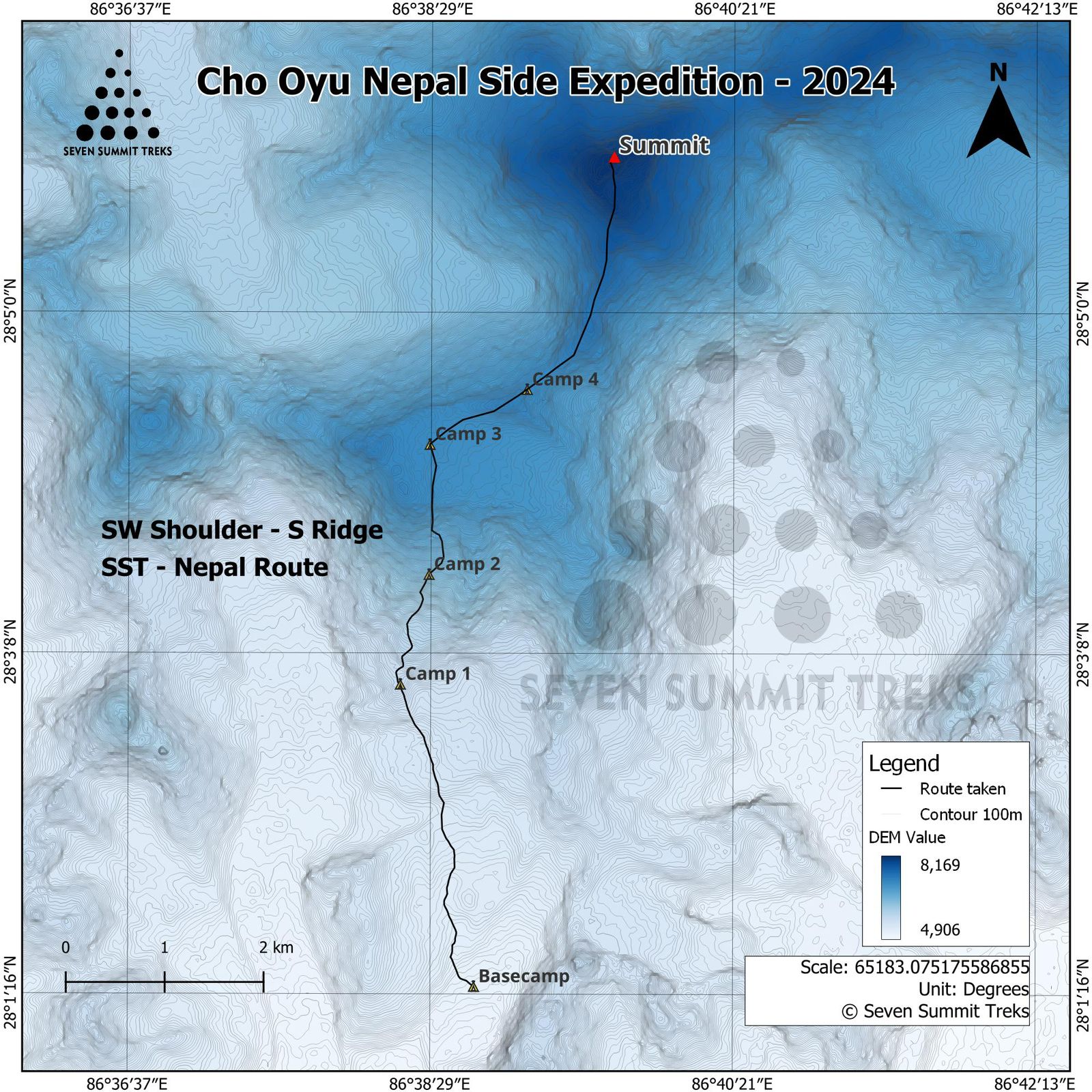Money
14 climbed Cho Oyu in 70 years. 7 did it last week to find route
On June 7, the expedition explored a commercial route, raising hope for the mountain’s viability from Nepal side.
Sangam Prasain
In February 1984, Maciej Berbeka and Maciej Pawlikowski of Poland became the first people to climb Cho Oyu, the sixth-highest mountain in the world, from the Nepal side.
The mountain, which straddles the Nepal-China border, lies 20 km west of Everest.
The 8,201-metre peak was first scaled in winter from the southeast pillar. The caravan route was Kathmandu-Lukla-Namce-Gokyo and Cho Oyu base camp.
After three years, in May 1987, Ang Phuri Sherpa became the first Nepali to reach the peak from the Nepal side. It was in spring. Then a group of Russian climbers summited the peak in the autumn of 1991, followed by two Japanese in 1994.
The last time Cho Oyu was conquered was in the spring of 2009, when Denis Urubko and Boris Dedeshko of Kazakhstan reached its top.
After a decade and a half, a seven-member Sherpa team, including a French national, reached the summit last week.
Cho Oyu is considered one of the most accessible 8,000ers from the Chinese side, while the Nepal side is considered among the toughest.
Only 21 people have reached Cho Oyu from Nepal’s side in the past 70 years. By contrast, more than 4,000 have successfully climbed the mountain from the Tibetan side. This makes Cho Oyo the second most climbed eight-thousander after Everest.
Among the 8,000ers, Cho Oyu has the lowest death rate.
On June 7, the French Alasdair McKenzie, with Gelje, Tenging Gyaljen and other sherpas, stood atop Cho Oyu at 8:35 pm via the southwest ridge. The caravan route was Kathmandu-Lukla-Namche-Thame and Cho Oyu base camp.
Unlike past expeditions, last week’s climb was meant to prepare a permanent route for a commercial expedition from the Nepal side.
“With this success, Cho Oyu has become more accessible from Nepal, heralding a new era in Nepali mountaineering and inspiring future expeditions to tackle its challenging routes,” said Mingma Sherpa, chairman of Seven Summit Treks, the agency which explored the local route.
Nepal boasts of eight of the 14 highest peaks over 8,000m on the planet. They are Everest, Kanchenjunga, Lhotse, Makalu, Dhaulagiri, Manaslu, Cho Oyu and Annapurna.
But to climb Cho Oyu, climbers usually had to go to Tibet first.
“From now onwards, commercial expeditions will happen from the Nepal side. This is good news for all expedition agencies. Climbers will no longer need to go through a long process of getting permission from the Tibetan authority. All eight mountains above 8,000 are now accessible from the Nepal side,” said Mingma.
Last Friday, the team started the summit push at 2:00 am from Camp IV, and after a relentless effort of over 18 hours, they made it to the top. “This remarkable achievement was the result of a meticulously planned expedition that started in March and commenced in the first week of May from Lukla,” said Mingma.
According to Mingma, a commercial expedition on Cho Oyu may last 60 days and could cost a foreigner between $25,000 and $30,000.
“That’s obviously a welcome development. It will create more jobs on the mountain,” said Ang Tshering Sherpa, former president of the Nepal Mountaineering Association.
“But it’s too early to say whether the route will be a commercial success,” he said.

For instance, the operating cost incurred from the Nepali side is nearly double that from the Tibetan side, in addition to the challenges a vertical wall poses.
Transporting goods from Kathmandu to the Cho Oyu base camp would cost $5 per kg. However, as the road reaches the advanced base camp or camp above the base camp of Cho Oyu from the Tibetan side, the cost on that route would be $2 per kg.
“There is a lot of difference in the operating costs. Climbing from the Tibetan side would cost $13,000 a person,” said Ang Tshering Sherpa. “So, obviously, the climber's preference would be the Tibetan side. First due to the lower factor, and, second, it’s an easier climb from the north.”
The success of the new route will depend on its commercial feasibility.
Mingma said Cho Oyu’s Nepal side is known for its steep, vertical walls rising thousands of metres, making it one of the greatest present-day challenges. He, however, said once the route becomes commercial, competition will bring down the cost.
“More than that, foreigners do not need to wait weeks or even months for the Tibetan authority’s permit to climb.”
The story of the first expedition, from the Tibetan side, however, is more interesting.
According to the archive of Nepal Tourism Board, the country’s tourism promotional body, Cho Oyu was first chosen for an expedition in 1952 in preparation for an Everest ascent the following year.
The first attempt of Cho Oyu from the Tibetan side was made by a British party led by Eric Shipton, with Edmund Hillary, George Lowe, Charles Evans, and Tom Bourdilon as its members. However, technical difficulties at an ice cliff above 6,650m forced them to give up the climb.
According to the archive, the expedition, led by the British Eric Shipton, was estimated to take two weeks. “It would also mean entering the Tibetan territory, which it is believed Shipton was unwilling to do,” according to the archive.
It was Shipton who first measured Cho Oyu as the sixth-highest mountain in the world.
An Austrian expedition, led by Herbert Tichy, arrived in Birgunj in 1954 via India and flew into Kathmandu on an Indian airliner of the time. Once they were packed and ready, they moved to Bhaktapur, from where the long trek to the mountain would begin.
There were only three foreign climbers and eleven sherpas on the team.
Cho Oyu was finally climbed on October 19, 1954, via the northwest ridge in Tibet by Tichy, Joseph Jöchler and Pasang Dawa Lama.
Before Cho Oyu, Everest and Annapurna in Nepal, and Nanga Parbat in Pakistan had been climbed.




 8.12°C Kathmandu
8.12°C Kathmandu













%20(1).jpg&w=300&height=200)
